|
|
BMe Research Grant |
|
George A. Olah Doctoral School of Chemistry and Chemical Technology
Department of Organic Chemistry and Technology
Supervisor: Dr. Andrea Toldy
Environmentally friendly flame retardancy of epoxy resin composites
Introducing the research area
Epoxy resins are extensively used as matrix materials in high tech composite applications. As the most important investigations of the aircraft industry focus on weight reduction of the aeroplanes, the ratio of polymer composites, owing to their significantly lower density compared to the metal parts, is significantly increasing. The fuselage and the wings of the new Boeing 787 Dreamliner are already prepared from composites (Figure 1), adding up to 50% of the total mass of the plane [1]. The flame retardancy of applied composites is indispensable for the safety of aviation. In this field, the general requirements concerning flame retardants are even more pronounced: they have to be effective at low concentration, should avoid the formation of toxic/corrosive gases during burning, and most importantly: they should not affect negatively the mechanical properties of the composite.

Figure 1: Materials used in the body of the Dreamliner
Brief introduction of the research place
The Technology of Pharmaceutical, Environmental and Safety Materials Research Group, operating at the Department of Organic Chemistry and Technology, in close collaboration with the Department of Polymer Engineering has an instrumentation unique in Hungary and is also recognized in Europe: multiple EU projects have been carried out with the participation of the departments.
History and context of the research
Due to their favourable properties, such as toughness, chemical, mechanical and electrical resistance, epoxy resins are widely used in different industries, mainly in electric industry and transportation, where the technological advantages of these resins can counter balance their relatively high price compared to other thermosets. Compared to metallic structural materials, the low density and increased strength and stiffness in the required directions are considerable advantages of composites. Their main drawback is, however, their flammability. As safety regulations are getting stricter, a demand for flame retarded composites which can satisfy both the mechanical and fire retardant (FR) requirements of aircraft industry has been arisen.
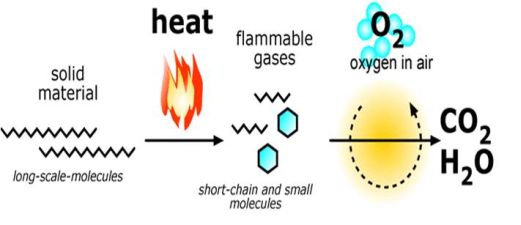
Figure 2: Combustion process
With flame retardant additives we can interfere in the combustion process (Figure 1) at different stages. The phosphorous derivatives are mainly applied as intumescent flame retardants. They are composed of a carbonizing (P-containing), a charring (in general polyols) and a foaming (mainly N-containing compounds) component. At high temperature, a charred layer is formed on the surface of the polymer, which is “blown up” by the N-containing gases, originating from the foaming agent, thus preparing a high, heat and gas insulating layer, which can protect the lower phase from further degradation (Figure 3).
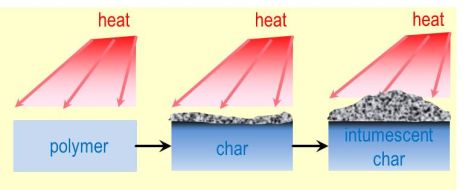
Figure 3: Mode of action of the intumescent flame retardants
The research goal, open questions
During the research, our aim was to synthesize phosphorus- and nitrogen-containing molecules which can ensure appropriate level of flame retardancy while maintaining the mechanical properties. In composite applications, the use of solid additive flame retardants (e.g. ammonium polyphosphate, APP) is not advantageous: during processing it can be filtered out on the reinforcing fibres, so the distribution will not be homogenous in the cross-section of the sample. Another option is the application of liquid additives (e.g. resorcinol bis(diphenyl-phosphate), RDP), however, deterioration of the mechanical properties and also loss of phosphorus due to its volatility at higher temperature are expected in this case. All these disadvantages can be eliminated by using reactive flame retardants when the unit responsible for the flame retardancy is incorporated into the macromolecular chain during polymerization. The application of multifunctional compounds is advantageous both economically and technologically. In our case it means that one of the components is also flame retardant. According to the literature, the best result in the reactive flame retardancy of epoxy resin composites is V-1 rating in UL-94 test [2], V-0 was achieved only with additive flame retardant [3], accompanied with poorer mechanical properties than that of the reference composite. Our aim was to achieve the best, V-0 rating in flame retardancy, while maintaining the mechanical properties at an acceptable level.
Methods
The flame retardant efficacy of the synthesized P-containing epoxy (EP-DOPO) and curing (TEDAP) components was investigated compared to a reference matrix. Samples containing P in 1-2-3 mass% were prepared by increasing the ratio of the corresponding FR component. For comparison, also APP-containing ones were produced in silicon moulds. The carbon fibre reinforced composites were prepared by the hand-lay-up method, which means that each layers were impregnated with the resin. The test-pieces were cut out with a band-saw. The samples were subjected to flame retardant and mechanical tests.
Flame retardant characterization
With the limiting oxygen index (LOI) measurement (Figure 4), a hierarchy of flammability can be established. The result of the measurement is an index about the flammability of the material, as the LOI value expresses the lowest oxygen to nitrogen ratio where specimen combustion is still self-supporting. The higher this value, the better the flame retardancy is.
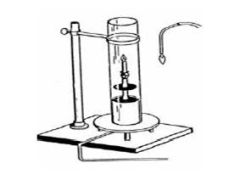
Figure 4: Limiting oxygen index measurement
UL-94 tests are used to determine ignitability, dripping and flame spreading rates. During the test, the specimens are mounted horizontally and vertically, ignited from beneath, and the time to flame extinction is measured (Figure 5). With decreasing burning times the ratings are increasing in the HB<V-2<V-1<V-0 direction.

Figure 5: UL-94 horizontal and vertical tests
Cone calorimeter is used for the determination of complex properties of the combustion (Figure 6). Simulating the circumstances of a real fire, the time to ignition, the heat release rate and the mass loss rate can be examined. The applied heat flux was 50 kW/m2. The behaviour of the material during burning, the amount of charring as well as the structure and consistence of the residues can also be observed.
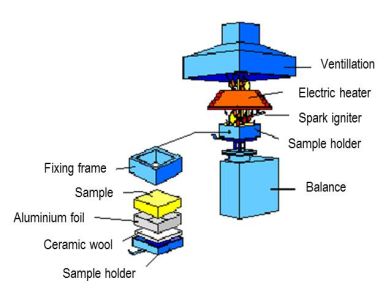
Figure 6: Schematic drawing of cone calorimeter
Mechanical tests
The prepared matrix (without any reinforcement) materials were subjected to standard tensile and three-point bending tests. In the case of composite samples, interlaminar shear strength measurement was also carried out (Figure 7), which was used to determine the behaviour of the matrix material in the composite applying shearing forces, and thus the adhesion between the polymer and the reinforcing fibres.

Figure 7: Specimen for the interlaminar shear strength measurement
Results
The flame retardant efficacy of the synthesized FR epoxy component (EP-DOPO) and P-containing hardener (TEDAP) was investigated by LOI and UL-94 tests, and was compared to the results of the additive APP (Table 1).
Table 1: LOI and UL-94 results of the matrices
|
Flame retardant |
LOI |
UL-94* |
|
reference |
23 |
HB (32 mm/min) |
|
APP_1%P |
27 |
HB (-) |
|
APP_2%P |
32 |
HB (-) |
|
APP_3%P |
32 |
HB (-) |
|
EP-DOPO_1%P |
23 |
HB (14.3 mm/min) |
|
EP-DOPO_2%P |
23 |
HB (-) |
|
EP-DOPO_3%P |
23 |
HB (-) |
|
TEDAP_1%P |
25 |
V-2 |
|
TEDAP_2%P |
30 |
V-1 |
|
TEDAP_3%P |
33 |
V-0 |
* in parentheses the flame spreading rates, where measurable
From the results it can be seen that the flammability decreased the most when the FR hardener (TEDAP) was used. The synthesized EP-DOPO did not prove to be suitable flame retardant in this system, so further investigations of this compound were suspended.
Regarding the results of the composites prepared from the reference and flame retarded matrices, it can be stated that due to the effect of the inflammable carbon fibres, the LOI value of the 1% P-containing sample exceeds the best result of the matrices, however, to reach V-0 rating, the application of 3% P is necessary (Table 2).
Table 2: LOI and UL-94 results of the reference and FR composites
|
Flame retardant |
OI |
UL-94 |
|
reference_composite |
31 |
HB (-) |
|
TEDAP_1%P_composite |
35 |
HB (-) |
|
TEDAP_2%P_composite |
37 |
HB (-) |
|
TEDAP_3%P_composite |
39 |
V-0 |
On investigating the mechanical properties of the composites, we found that the samples cured with the polar flame retardant curing agent (TEDAP) showed significantly lower fibre–matrix adhesion, thus the strengths were significantly lower than those of the reference composite (Figure 8).
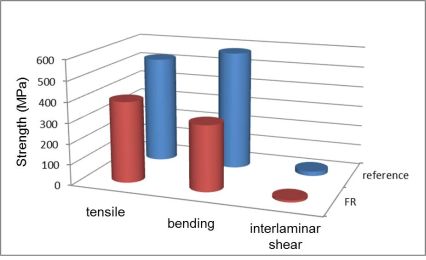
Figure 8: Mechanical properties of the reference and FR composites
The cone calorimeter test (Figure 9) proved that by using the flame retardant curing agent the heat release rate decreased significantly both in the case of matrices and composites, while the time to ignition increased, compared to the reference samples. At the same time, it can be seen that the stiff carbon fibres hinder the intumescence, thus no appropriate charred layer can be formed, resulting in practically unlimited heat and oxygen transport and more intense burning.
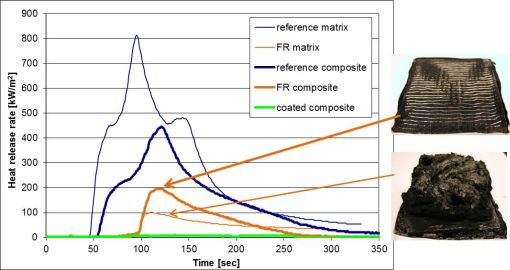
Figure 9: Results of the cone calorimetric measurements
To eliminate the above-mentioned problems, the preparation of a coated composite can be a suitable approach (Figure 10). In this case, as the flame retardant can act unhindered, the heat release rate fluctuated around zero (Figure 9). The mechanical performance also ameliorated significantly, as the load-bearing core was composed from unmodified reference composite, while the shell layers were made from flame retarded matrix and acted only as surface coating.
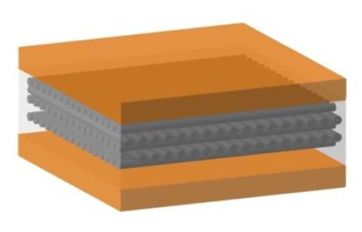
Figure 10: Schematic drawing of the coated composite
The flame retardant efficacy of TEDAP led us to the elaboration of an alternative synthesis pathway, which aimed at the supersession of the former highly exothermic reaction using harmful reagent as starting material (P(O)Cl3). The elaborated new method is advantageous from both green chemistry and economical aspects. The new reagent (triethyl phosphate) is inexpensive and readily available in large quantities and the applied amine serves also as solvent and can be reused in the subsequent batches. No harmful by-products are formed during this one-step reaction and the atomic efficiency is significantly increased, too(Figure 11). Based on these considerations, the new reaction pathway is suitable for large-scale industrial production as well.

Figure 11: The original (top) and the elaborated “green” reaction pathway
Expected impact and further research
The newest research direction of the epoxy resins is the development of compounds originating from renewable sources. In the near future, we plan to investigate the efficacy of the synthesized FR component in sugar-based epoxy resins. The flame retardants have to be optimized to a given resin system, as their structures are very different.
For the preparation of biocomposites, the application of reinforcing fibres from renewable sources is obvious. In many cases, the natural-fibre reinforcement represents a suitable and environmentally friendly alternative of the currently applied carbon and glass fibres, which are prepared with high energy consumption. However, their flammability is a considerable drawback. This disadvantage can be overcome by treating the biofibres with P-containing additives. Therefore, my further research will focus on these areas.
Publications, references, links
Related publications
[SzB1] A. Toldy, B. Szolnoki, Gy. Marosi: Flame retardancy of fibre-reinforced epoxy resin composites for aerospace applications, Polymer Degradation and Stability, 2011, 96(3), pp. 371-376
[SzB2] O. Unsalan, B. Szolnoki, A. Toldy, G. Marosi: FT-IR spectral, DFT studies and detailed vibrational assignment on N,N′,N″-tris(2-aminoethyl)-phosphoric acid triamide, Spectrochimica Acta Part A: Molecular and Biomolecular Spectroscopy, 2012, 98, pp. 110-115
[SzB3] B. Szolnoki, A. Toldy, P. Konrád, G. Szebényi, Gy. Marosi: Comparison of additive and reactive phosphorus-based flame retardants in epoxy resins, Periodica Polytechnica Chemical Engineering, 2013, 57(1-2), pp. 85-91
[SzB4] A. Toldy, B. Szolnoki, I. Csontos, Gy. Marosi: Green chemistry approach for synthesizing phosphorus flame retardant cross-linking agents for epoxy resins, Journal of Applied Polymer Science, 2014, 131(7), 40105
[SzB5] B. Szolnoki, K. Bocz, P.L. Sóti, B. Bodzay, E. Zimonyi, A. Toldy, B. Morlin, K. Bujnowicz, M. Wladyka-Przybylak, Gy. Marosi: Development of natural fibre reinforced flame retarded epoxy resin composites, Composites Part A: Applied Science and Manufacturing, 2014, submitted
[SzB6] Toldy A., Szolnoki B., Czeller A.: Égésgátolt szénszál-erősítésű epoxigyanta kompozitok fejlesztése repüléstechnikai alkalmazásokhoz (in Hungarian), Műanyag és Gumi, 2010, 47(10), pp. 384-386
[SzB7] B. Szolnoki, Gy. Marosi, A. Toldy: Multilayer flame retarded epoxy resin composites for aircraft applications, 14th European Conference on Composite Materials, Budapest, 2010
[SzB8] A. Toldy, B. Szolnoki, A. Szabó, B. Bodzay, Gy. Marosi: Comparison of flame retardant and mechanical performance in aliphatic and aromatic epoxy resins, 7th European Workshop on Phosphorous Chemistry, Budapest, 2010
[SzB9] B. Szolnoki, A. Toldy, Gy. Marosi: Effect of moisture absorption on the mechanical properties of epoxy resins, 6th International Conference on Modification, Degradation and Stabilization of Polymers, Athens, Greece, 2010
[SzB10] K. Madi, B. Szolnoki, K. Bocz, A. Toldy, Gy. Marosi, K. Bujnowicz, M. Wladyka Przybylak: Flame retardancy of hemp fabric reinforced epoxy resin composites, International Conference on Bio-based Polymers and Composites, Siófok, Hungary, 2012
[SzB11] B. Szolnoki, B. Bodzay, Zs. Rapi, P. Bakó, A. Toldy, P. Bagi, Gy. Keglevich, Gy. Marosi: Characterization of flame retardant epoxy resins from renewable sources, X. Conference of György Olah Doctoral School, Budapest, 2013
[SzB12] B. Szolnoki, K. Molnár, G. Szebényi, A. Toldy, G. Marosi: Flame retardancy of epoxy resin composites reinforced with CNT-loaded carbon nanofibre, 14th European Meeting on Fire Retardancy and Protection of Materials, Lille, France, 2013
Links
Technology of Pharmaceutical, Environmental and Safety Materials Research Group
Department of Polymer Engineering
resorcinol bis(diphenyl-phosphate)
References
[1] P.M. Hergenrother, C.M. Thompson, J.G. Smith Jr., J.W. Connell, J.A. Hinkley, R.E. Lyon, R. Moulton: Flame retardant aircraft epoxy resins containing phosphorus, Polymer, 2005, 46(17), pp. 5012-5024
[2] U. Braun, A.I. Balabanovich, B. Schartel, U. Knoll, J. Artner, M. Ciesielski, M. Döring, R. Perez, J.K.W. Sandler, V. Altstädt, T. Hoffmann, D. Pospiech: Influence of the oxidation state of phosphorus on the decomposition and fire behaviour of flame-retarded epoxy resin composites, Polymer, 2006, 47(26), pp. 8495-8508
[3] B. Perret, B. Schartel, K. Stöß, M. Ciesielski, J. Diederichs, M. Döring, J. Krämer, V. Altstädt: Novel DOPO-based flame retardants in high-performance carbon fibre epoxy composites for aviation, European Polymer Journal, 2011, 45(5), pp. 1081-1089
